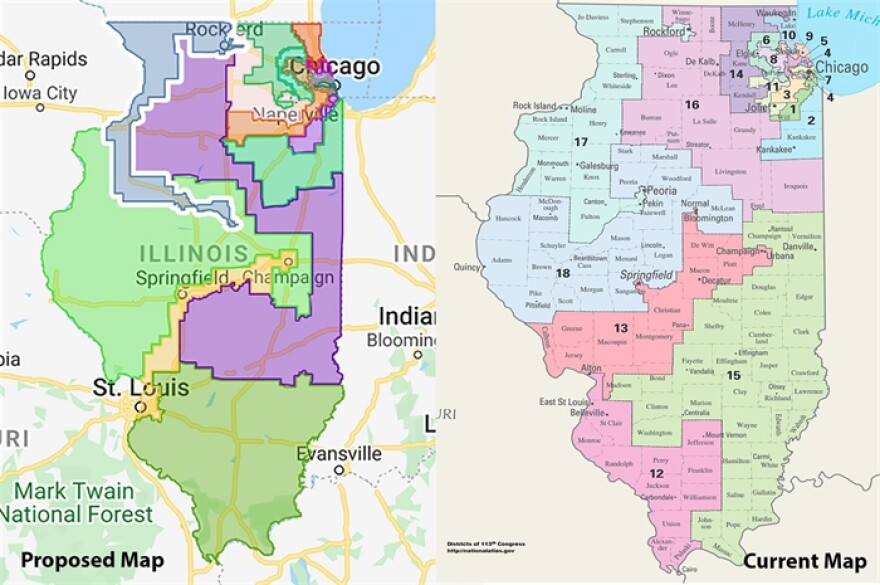Illinois’ proposed congressional map isn’t pretty, but looks may not matter if the new district lines achieve Democrats’ goal of squeezing as many blue seats as possible from the state in 2022.
State Democrats, who control both legislative chambers and the governor's office, are under pressure from national party leaders to produce a map that maximizes the number of seats that Democrat candidates can win, said Jim Nowlan, a former Republican Illinois state legislator and longtime political observer in the state.
“The Democrats are doing everything they can,” he said. “They’re putting pressure on the Illinois mapmakers to do the same and come up with 14 [seats] out of 17 rather than 13 out of 17.”
Now there are 13 Democrats and five Republican representatives in Congress.
Nowlan chafes at the mapmaking, calling it a perfect illustration of candidates selecting their voters rather than the opposite.
“The boundary lines are atrociously offensive to citizens who like to think of themselves as part of communities of interest,” he said. “It’s an abuse of democracy really.”
The way the map treats Metro East communities is a clear example of this, Nowlan said. For example, the new 13th District, now represented by Republican Rodney Davis, would combine more populous and Democratic-leaning parts of the region, like Belleville and East St. Louis, with Springfield, Decatur and Champaign.
Under the proposed map, the 13th District wouldn’t have an incumbent. Davis would run in the 15th District and Republican Mary Miller, the 15th’s current incumbent, would run in the 16th, which is represented by Republican Darin LaHood.
The new 13th District is akin to one resembling a salamander in New England in the 19th century that spawned the term “gerrymander,” Nowlan said.
“This is worse than the salamander, it’s a worm,” he said. “Absurd as the maps look, they probably will pass legal muster on racial minority grounds and equal population grounds, with the Supreme Court in 2019 having said that partisan gerrymandering is not a justiciable issue.”
But Illinois Democrats may have more to worry about than this map passing constitutional muster, said Frank Calabrese, a political consultant and mapmaking expert.
“There are concerns it’s not very good to Democrats, that it’s not going to make the congressional makeup of Illinois all that more Democratic,” he said. “There’s a chance of when you overextend your members that they all face a risk.”
Calabrese explained this becomes apparent when viewing the new districts through the lens of past statewide election turnouts, such as in 2020 and 2018. This can help create a partisan index that shows how a candidate may perform in a certain district, he said.
“Trump and Biden numbers are a little special because in the suburbs in Illinois, Trump underperforms local Republican performance and Trump does stronger than some Democrats in rural areas,” Calabrese said.
Numbers from the 2020 presidential election show a map that produces 14 Democratic-leaning seats. But using turnout numbers from the 2018 General Election for Illinois attorney general and governor show the proposed congressional map netting 11 and 12 Democratic seats, respectively.
Calabrese stressed that these are not the final maps and that they may significantly change as lawmakers negotiate the district boundaries.
Illinois state Democrats are in a bind because other traditional Democratic-leaning states, like Michigan and California, have independent commissions that disarm their redistricting advantage, Calabrese said.
“Illinois is very important for national Democrats,” he said. “That’s because Republicans that control states like Texas and Florida are trying to elect as many Republicans at the expense of Democrats during their redistricting processes.”
East St. Louis statehouse lawsuit
There’s also political drama surrounding statehouse legislative maps after the East St. Louis branch of the NAACP filed a lawsuit alleging the new boundaries are a racial gerrymander.
The federal suit, filed last Friday, claims the map divides the Black community in the East St. Louis area to bolster white House incumbents in the 112th and 113th districts at the expense of the 114th District, represented by LaToya Greenwood, D-East St. Louis. Jay Hoffman, D-Swansea, and Katie Stuart, D-Collinsville, represent the 112th and 113th districts.
The lawsuit alleges the new boundaries deprive Black voters an equal opportunity to elect their candidates of choice.
These cases can be tricky to prove, said Michael Li, senior counsel in the democracy program at the Brennan Center for Justice.
“The Supreme Court has said race cannot predominate in the drawing of a district, which is actually something courts struggle with a lot,” he said. “They find them really hard to decipher, because you’re trying to parse out, 'What is the motive of a map drawer?’”
This becomes increasingly complicated because of the 2019 Supreme Court ruling on partisan gerrymandering, Li said. He added it’s also complex because the Voting Rights Act requires states consider race when redistricting.
“Are you drawing a district based on the fact that these voters are Black or are you drawing a district because these voters are Democrats?” he said. “You have to parse that out and it can be really tricky.”
Simply moving populations around may not constitute a racial gerrymander, Li said.
“The key in the analyses under the Voting Rights Act is whether communities of color have the ability to elect their preferred candidates, whoever that preferred candidate is,” he said.
Eric Schmid covers the Metro East for St. Louis Public Radio as part of the journalism grant program: Report for America, an initiative of The GroundTruth Project.






